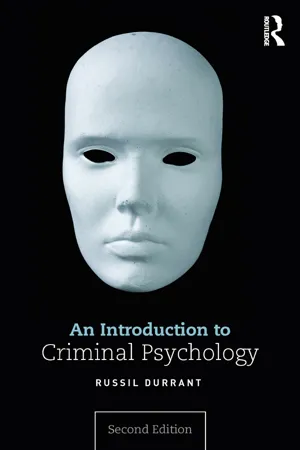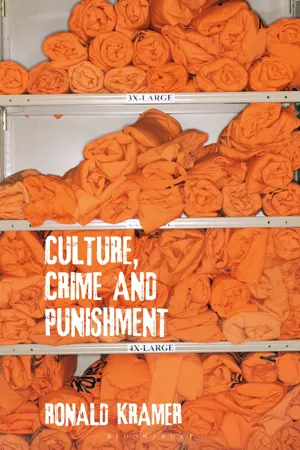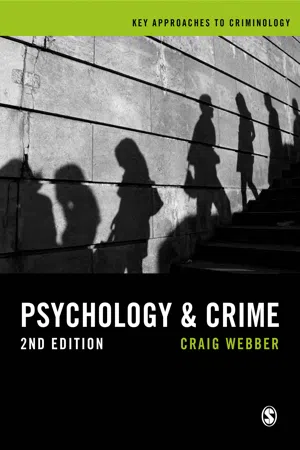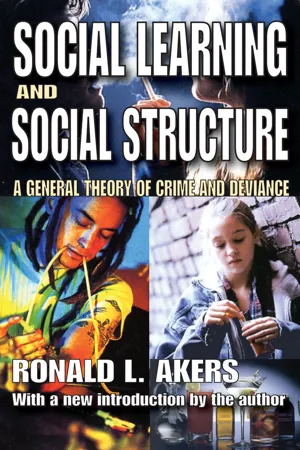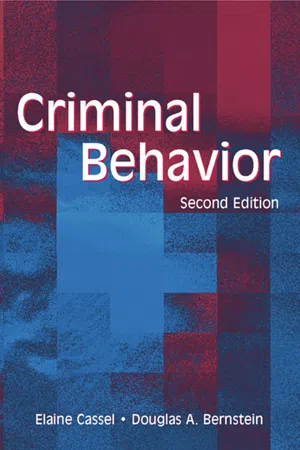Crime and Culture
"Crime and Culture" refers to the relationship between criminal behavior and cultural influences. It explores how cultural norms, values, and beliefs can shape individuals' attitudes towards crime and influence their likelihood of engaging in criminal activities. This area of study examines the impact of cultural factors on the prevalence and perception of crime within different societies.
8 Key excerpts on "Crime and Culture"
- eBook - ePub
Psychological Criminology
An Integrative Approach
- Richard Wortley(Author)
- 2011(Publication Date)
- Willan(Publisher)
...However, whether or not such offenders are labelled pathological involves a qualitative judgement that does not materially affect the scientific search for the causes of their behaviour. Criminal behaviour is the result of acquired deviant motivations and behaviours, and a failure to inhibit natural criminal impulses. The inherent tendency for human beings to act out of self-interest helps account for the latent propensity for criminal conduct in the general population, and the criminal versatility of many offenders. All criminal behaviour results from the combination of dispositional and situational factors. The probability of crime therefore varies according to both the criminal characteristics of the individual and the criminogenic nature of the immediate crime setting. Psychological Theories of Crime and Criminality: an Integrated Model We now turn to consider the psychological theories that will go into the integrative model. In sociological criminology, theories are typically developed specifically for the purpose of explaining crime and criminality. In contrast, there are very few distinctly criminological theories in psychology. Instead, criminal behaviour is treated as just another human response that obeys more general psychological rules, and that can therefore be explained by mainstream psychological theory. Individual psychological theories, in turn, often have a narrow focus, emphasising the role of some particular psychological factor or process. Eight areas of theory are covered in this book, each of which is the subject of a chapter. These eight areas can be arranged in a temporal sequence, from a focus on distal to proximal causal factors, suggested by the nature/nurture and the person/situation debates. Some theories focus on factors that are present at birth; other theories focus on factors that influence the offender over the lifespan; and other theories focus on factors that are present at the crime scene...
- eBook - ePub
- Russil Durrant(Author)
- 2018(Publication Date)
- Routledge(Publisher)
...As such, they draw heavily on social-structural and cultural factors in accounting for crime. The idea of social structure refers to the way that society is organised. The term, therefore, can be used to refer to the prevailing political, economic, legal, and other social frameworks and institutions that are in place and how these affect the relations among individuals in ways that influence criminal behaviour. In particular, criminologists are often interested in how specific social-structural arrangements affect particular groups of individuals such as women, ethnic minorities, and those from deprived social backgrounds. Culture is a somewhat nebulous concept but, generally speaking, it is used to refer to shared patterns of beliefs, values, norms, and practices that can define specific social and ethnic groups. Cultural and social-structural explanations are conceptually distinct, but are often combined in mainstream criminological theory. For instance, specific social arrangements may give rise to structural inequalities that lead to the formation of ‘sub-cultural’ groups defined by specific values, norms, and practices. As this is a criminal psychology textbook it was tempting to leave these theoretical perspectives to one side. However, although they will not get the prominence that they might in mainstream criminology textbooks, they do provide some important explanatory resources that should form part of our explanations for criminal behaviour...
- eBook - ePub
- Ronald Kramer(Author)
- 2020(Publication Date)
- Bloomsbury Academic(Publisher)
...3 THE CONCEPT OF CULTURE AND CRIMINALISED BEHAVIOUR Introduction The fundamental elements of cultural criminology – its theoretical origins, conceptual repertoire, methodological preferences and political orientations – were treated over the course of Chapters 1 and 2. In this chapter, we turn to how cultural criminology has sought to theorise criminalised behaviour, a topic that would seem unavoidable given that criminology and crime are so thoroughly interrelated. Within cultural criminology, crime is not a straightforward concept. As noted in Chapter 1, there is a strand of thought in which crime is understood not as behaviour that transpires in the real world, but as a category that constructs some behaviours as criminal. In the theoretical pantheon of cultural criminology, this view is often attributed to Howard Becker (1963) and his notion of labelling, but it is also discernible in the radical constructivist position. Despite seeing crime as a cultural construct, the concept of culture has simultaneously been utilised to develop theoretical accounts concerning the motivations to criminalised behaviour. To be sure, and as noted in the concluding remarks of Chapter 1, there is a major dilemma here: crime cannot be understood as something that inheres in actual behaviour and, at the same time, a cultural or discursive resource that constructs reality. These views are logically incompatible. As such, crime is either real and can be explained, or crime is discursive and its use as a category warrants interrogation. This chapter is organised around accounts that accept – at least to some degree – the first of these propositions (crime exists and can be theorised). Four broad ways in which a concept of culture has figured in attempts to explain crime are discussed. The chapter begins with ‘culture of poverty’ arguments, in which poverty is seen as generating specific cultural sensibilities that are conducive to crime...
- eBook - ePub
Psychology and Crime
A Transdisciplinary Perspective
- Craig Webber(Author)
- 2019(Publication Date)
- SAGE Publications Ltd(Publisher)
...This means that there is nothing that is out of the remit of social psychological study. This is because, in a similar way to sociology, every human endeavour is social. Going back to the earliest studies in sociology, such as Durkheim’s Suicide, this seemingly most personal of actions had a social foundation (Durkheim 1897/1951). Consequently, topics as diverse as aggression, gang formation, prejudice, religious affiliation and nationality are all topics that can be studied by social psychologists. The benefit of social psychology for crime is that crime is not only a socially embedded activity since the criminal necessarily has to interact with others – so it is personal, interpersonal and social – but also because if we take the view that crime is the breaking of the law, then law is a socially constructed set of rules as we discussed in Chapter 1. Under this definition we can only be a criminal if there is a law that is broken. If a psychological phenomenon is said to be the cause of crime and that crime is rendered legal because of a change in the law then the psychological phenomenon can only be said to be the cause of a certain type of behaviour. Social psychology is able to deal with these nuances and so becomes a very useful discipline to study crime. Summary This chapter has looked at the six key areas of psychology that are regarded as the core perspectives of contemporary psychology. Added to these we have also looked at psychoanalysis, a topic that has been rendered more marginal in psychological teaching as psychology has shifted to a more empirical model of research and teaching. It is clear that these areas are not discrete, but overlap in many ways, and new approaches have developed out of the problems that have been identified with older approaches...
- eBook - ePub
- Ian Marsh, Ian Marsh(Authors)
- 2007(Publication Date)
- Routledge(Publisher)
...CHAPTER 3 Psychological Explanations for Criminal Behaviour INTRODUCTION For many centuries, we have attempted to find out which people are likely to become criminals and what drives certain individuals to commit a particular type of crime in the first place. Over the years psychologists have considered a range of different explanations in order to answer these difficult questions. Some have argued that there may be a genetic explanation which is at the centre of explaining criminal behaviour; others have suggested that it is the environment in which people live which can influence their chance of becoming criminal. At different periods in history these ideas have been prominent in the minds of not only psychologists but also other professionals and the public alike. However nobody has seemingly provided a comprehensive and infallible answer to the question of criminality. This chapter will introduce some of the key theories that psychologists have attempted to use to explain criminal behaviour, such as personality, social factors and cognition. CRIMINALITY AS AN ELEMENT OF PERSONALITY It is common for us to attach labels to criminals and attempt to explain their behaviour through describing them as possessing a certain character trait. For example, it is common to refer to some criminals as ‘psychos’—particularly in films and the newspapers. This type of person is actually called a psychopath and labels such as these have been developed by psychologists to help us understand the different types of personality category that people fit into. Not all of these are criminal, but it is assumed that many criminals possess similar personality characteristics. Clearly there are some important factors to criminality that can be explained by situational and developmental factors, but there is also the psychological element to criminal activity that is relatively unique to that individual...
- eBook - ePub
Drugs and Crime
Theories and Practices
- Richard Hammersley(Author)
- 2015(Publication Date)
- Polity(Publisher)
...In smaller communities conflict over resource and status issues could be resolved personally and often peacefully because everyone knew everyone else. Laws impose abstract norms on people instead: it is wrong not only to hit your mother, but to hit anyone. Civilized as society has become, not everyone agrees. The basic motives of acquiring resources and gaining social status are still with us. Indeed they are encouraged in open societies, as long as citizens do not break the law and as long as they aspire to the right sorts of resources and the right kind of social status. The lawmakers do not think highly of drugs, flash cars and ‘bling’: better fine wines, a mortgage and a business suit. ‘Crime’ is not an absolute thing, but relative to who is doing what and to whom, and who is observing and defining the actions. The police can offend in part because they are often able to ensure that the offence is undetected. It is also of importance that much crime as experienced then reported by victims in crime surveys was never reported to the police to become part of the official statistics – the ‘dark figure’ (MacDonald, 2001). Additionally, how you ask the questions in crime surveys affects how respondents answer (Farrall et al., 1997). Furthermore, ‘everyday’ crime, such as running red lights and failing to report taxable income, is probably committed on a larger scale than the kinds of crime linked to drugs (Karstedt and Farrall, 2006). One example of major cultural variation in crime is that some Native American cultures traditionally lack the sort of concept of personal property that allows the crime of ‘theft’. In these cultures, basically objects do not belong to people forever independently of need, and it is acceptable to take things that others are clearly not going to be using for the time that you need them...
- eBook - ePub
Social Learning and Social Structure
A General Theory of Crime and Deviance
- Ronald Akers(Author)
- 2017(Publication Date)
- Routledge(Publisher)
...But their hypothesis is simply that one's location in the social system, as indicated by such characteristics as race, sex, and age, means that one will be differentially exposed to and learn definitions favorable and unfavorable to law violation (whatever the source of those definitions). Such a hypothesis does not require that each of these sociodemographic categories constitute an interacting group with a singular culture into which men, young people, or blacks are obediently enculturated. Cressey (I960) made it clear that the conflict can come from normative variations and discontinuities in the same social system to which both sexes, all ages, and all races are exposed, as well as from differences among subcultures. Definitions and Motivation for Criminal Behavior The cultural deviance critique depicts the differential association process in criminal behavior as one in which internalizing definitions favorable to crime (1) "requires" the person to behave in violation of conventional norms and (2) provides the "sole" motivation for behavior. Theories in the cultural deviance tradition suggest that in committing his acts the delinquent is living up to the norms of his culture. These theories usually suggest the existence of beliefs that positively require delinquent acts. (Hirschi, 1969:197; emphasis added) Internalized cultural values [according to differential association theory] provide the sole basis of motivation. . . . This view [Sutherland's] assumes first that there are no other determinants of human behavior than values. (Kornhauser, 1978:195-96; emphasis added) Since cultural definitions are wholly determinative, and no other source of motivation is allowed to counteract them, all socialization is "perfectly successful," and all members of the group are rendered incapable of acting in any way contrary to the deviant norms...
- eBook - ePub
- Elaine Cassel, Douglas A. Bernstein(Authors)
- 2007(Publication Date)
- Psychology Press(Publisher)
...Psychological development begins with the shaping of one’s personality, the unique patterns of thinking, feeling, and behaving that develop early on and remain relatively constant throughout one’s life. Personality development is a complex interaction of bio FIGURE 5.5 Early Precursors of Antisocial Personality Disorder. From Abnormal Psychology, by M. T. Nietzel, M. Speltz, E. McCauley, & D. A. Bernstein, 1998, Boston: Allyn & Bacon. Copyright © 1998 by Allyn & Bacon. Reprinted by permission of authors. logical and environmental factors. Certain personality traits, for instance, extroversion, impulsiveness, and aggressiveness, are more associated with criminal behavior than are others. The psychodynamic theories of Freud, Erikson, Sullivan, and the object relations theories explain crime and violence as the result of interpsychic forces. Freud’s approach was more biological, whereas Erikson’s and Sullivan’s emphasized social interactions more. The object relations theories of Klein, Kohut, and Mahler, have focused on maladaptive relationships with caregivers as setting the stage for maladaptive behavior. The learning theories of Skinner and Bandura are helpful in explaining how aggression and violence are acquired through rewards, reinforcement, and the modeling of others. Combinations of poor parenting in which children do not learn to behavior in law-abiding ways and observing aggression and violence in others may lead to criminal offending. Piaget and Kohlberg have helped explain criminal behavior from a cognitive perspective. Piaget has helped us understand how people learn to think and reason generally through the development of cognitive schemas, whereas Kohlberg was concerned with how children and adults engage in moral reasoning and decision making...

